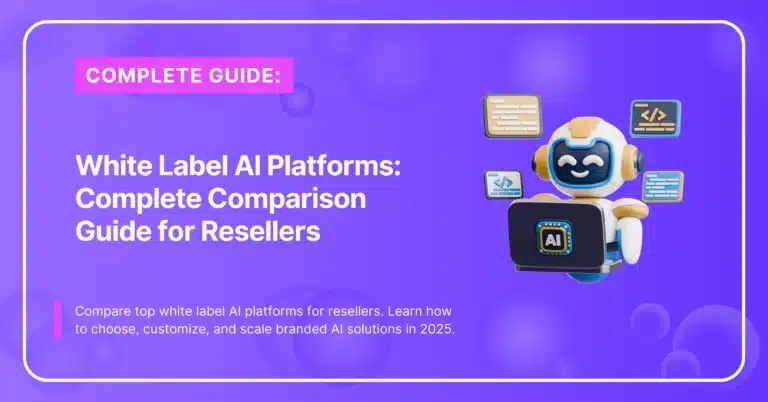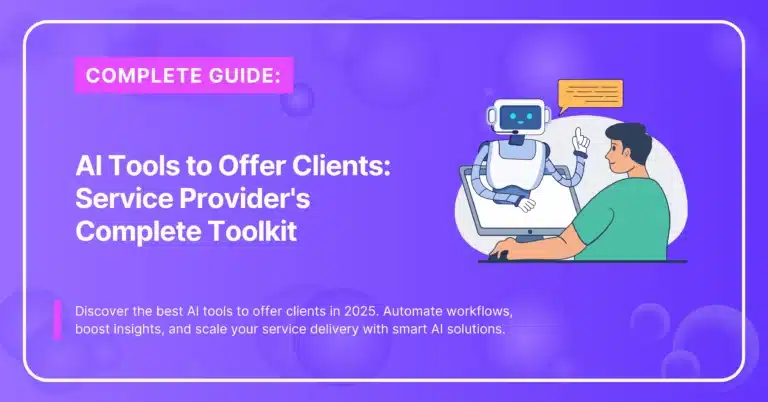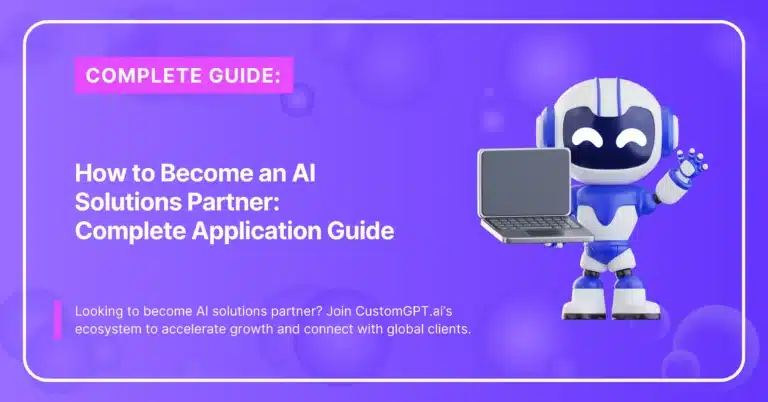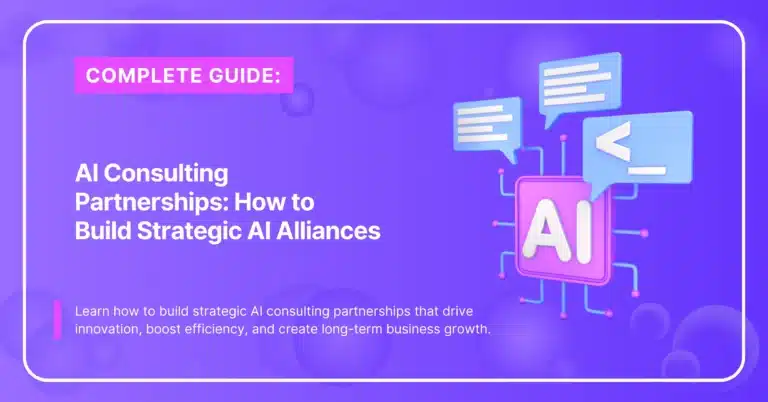In the world of AI, teams speed up innovation by leaning on a community of partners—hardware gurus, cloud architects, model creators, and integration specialists.

Make Money With AI
Join our Partner Programs!
Boost your reputation, drive revenue and grow your business with CustomGPT.ai.
Together, they assemble flexible, plug‑and‑play solutions that grow from simple prototypes to full-scale rollouts.
This collaborative approach not only cuts down development cycles but also ensures each deployment is tailored, reliable, and ready for real-world impact.
In this article, we will explain step by step how to build, engage, and optimize your own AI vendor ecosystem for lasting success.
Defining Vendor Ecosystems in AI
A vendor ecosystem goes beyond a network of suppliers—it’s a live framework of shared innovation, data integration, and co-evolution. When designed effectively, these ecosystems reduce friction, encourage co-creation, and accelerate deployment.
1. Modular Architectures
Partners contribute APIs, pre-trained models, or cloud services that plug together via open standards (e.g. ONNX), streamlining development.
2. Aligned Incentives and Governance
Clear data-sharing protocols and co-development agreements prevent fragmentation and build trust.
3. Centralized Integration
Secure platforms unite knowledge from across the ecosystem, powering reusable AI agents for helpdesks, training, and content generation.
Strategic Engagement with Vendor Ecosystems
Engagement isn’t transactional—it’s a deliberate, quality-focused orchestration built on foundational mechanisms.
Partner Programs That Simplify Go-to-Market
Well-designed partner programs provide structured certification tracks, joint marketing initiatives, and co-selling resources. They establish clear tiers with performance incentives, enable shared lead generation through integrated CRM tools, and offer technical enablement via training labs.
By standardizing onboarding and aligning sales motions, these programs reduce complexity, ensure consistent customer experiences, and speed revenue cycles.
- Focused Partner Networks: Smaller, deeply integrated partner networks often outperform sprawling alliances, delivering clearer alignment and faster execution.
- Data Interoperability Standards: Standardized formats and APIs (as seen in Snowflake’s Data Cloud) allow partners to co-develop without system conflicts.
- Dynamic Collaboration Frameworks: Flexible agreements let partners recalibrate roles and goals as conditions change, guided by real-time performance analytics.
The Role of AI Authority
Becoming an AI authority requires embedding vendor ecosystems into your core
- Co-develop Domain-Specific Models: Collaborate with partners to build specialized AI solutions using industry-specific data (e.g., finance risk analytics, healthcare diagnostics), delivering precision and competitive edge.
- Target High-Adoption Verticals: Prioritize sectors like finance and healthcare, where clear ROI and regulatory drivers accelerate AI uptake and impact.
- Invest in Centers of Excellence: Establish cross-functional teams to steward AI expertise, oversee governance, and foster continuous learning, ensuring ecosystem contributions align with strategic goals.
- Embed Adaptive Governance: Implement transparent data-sharing protocols, compliance frameworks, and ethical guidelines to maintain trust, manage risk, and enable rapid iteration.
Establishing Organizational AI Authority
Transform your ecosystem into an engine of innovation by operationalizing partner contributions.
- Identifying High-Value Use Cases: Align internal goals with partner strengths to tackle complex domain-specific problems.
- Standardizing Interoperability: Merge diverse components seamlessly using open protocols and centralized platforms for secure, scalable access.
- Provider Pricing and Packaging of AI Services: Pricing models range from consumption-based billing for cloud credits to tiered subscription packages bundling compute, support, and licensed models. This clarity simplifies procurement and aligns costs with outcomes.
- Vendor-Managed Future-Proofing: Leading vendors handle model updates, compliance monitoring, and security patches within their service offerings, ensuring deployments remain current and compliant without heavy in-house maintenance.
Challenges and Misconceptions in AI Ecosystems
Many organizations underestimate the hurdles in moving from small pilots to enterprise-grade AI. The most common challenges include:
- Proof-of-Concept vs. Production: Initial demos often succeed in sandbox environments, but without the right operational frameworks—like DevOps practices, scalable infrastructure, and change management—AI pilots struggle to transition into reliable, full-scale deployments.
- Tools ≠ Success: Cutting-edge platforms and vendor tools are only part of the solution. Without robust data pipelines, API integrations, and ongoing maintenance processes, even the best technology under delivers.
- Misaligned Priorities: Ecosystem partners, internal stakeholders, and end-users may have different definitions of success (e.g., feature speed versus system reliability). Without shared KPIs and regular feedback loops, collaboration breaks down and projects lose momentum.
To navigate these pitfalls, organizations must unify data governance, establish clear end-to-end deployment processes, and integrate AI insights directly into their decision-making workflows.
Bridging the Gap
Solution partners act as the bridge between vendor innovations and end-user realities by translating technical capabilities into tailored, deployable solutions.
They integrate modular components—hardware, cloud services, pre-trained models—and align them with customer needs through structured implementation frameworks.
By maintaining feedback loops between vendors and clients, they ensure continuous optimization, handle change management, and deliver tangible business outcomes. This bridging role accelerates adoption, reduces deployment risks, and connects strategic vision with operational execution.
Partnering with the Right Experts
When complex AI initiatives need a guiding hand, solution partners fill critical roles: they translate vendor roadmaps into actionable plans, extend in-house capabilities with specialized skills, and ensure smooth rollouts.
By offering hands-on expertise—from architectural design and data preparation to change management and user training—these experts turn ambitious AI strategies into tangible results.
Their continuous collaboration and domain knowledge help organizations avoid common pitfalls, shorten implementation timelines, and achieve measurable business outcomes.
Introducing CustomGPT.ai Solutions Partner Program
CustomGPT.ai’s Solutions Partner Program equips technology firms and consultants with the tools, training, and support needed to deliver AI solutions that drive business impact. Program benefits include:
- Comprehensive Certification: Step-by-step training and technical exams ensure partners are fully accredited to design, implement, and optimize CustomGPT.ai deployments.
- Co-Marketing and Sales Enablement: Ready-made collateral, joint campaign planning, and shared leads help partners reach new customers and grow pipeline faster.
- Attractive Partner Incentives: Competitive revenue shares, performance bonuses, and referral rewards make every successful project more profitable.
- Early Product Access: Preview upcoming features in sandbox environments, provide feedback directly to our product team, and differentiate your service offerings.
- Collaborative Community: Participate in partner councils, workshops, and virtual roundtables to exchange best practices and build connections.
By combining specialized expertise with CustomGPT.ai’s innovative platform, partners accelerate rollout timelines, maintain high-quality performance, and stay ahead in fast-moving markets.
What You Get as a Solutions Partner
Partners enjoy a suite of exclusive benefits designed to boost profitability, streamline deployments, and elevate market presence:
- Significant Enterprise-Plan Discount: Access our full-feature platform at partner-only rates.
- Up to 20 % Commission for Two Years: Rewarding margin structure on every client deployment you drive.
- 15 Days Free on Partner-Enterprise Plan: Generate proof-of-value with no up-front fees, then transition to a heavily discounted rate.
- Featured in Our Solutions Directory: Boost your visibility to enterprise buyers actively seeking CustomGPT.ai expertise.
- Dedicated Partner Support: A named Partner Success Manager and technical team available for onboarding, troubleshooting, and strategic planning.
- Co-Selling Opportunities: Work side-by-side with our experienced sales representatives on joint pursuits.
- Exclusive Early Access: Be first in line to try new products, features, and platform enhancements before general release.
How to Become a CustomGPT.ai Solutions Partner
Getting started is straightforward: follow these three easy steps to join our program and begin delivering AI-driven value to your clients.
Step 01: Schedule a Consultation
Begin with a one-on-one call with our Partner Management Team to explore how CustomGPT.ai integrates into your offerings, uncover new revenue opportunities, and outline the support structure we’ll provide.
Step 02: Experience a 15-Day Trial
Gain hands-on access to our platform with expert guidance—coaching sessions, co-selling strategies, and tailored sales resources—to kickstart client engagements.
Step 03: Launch as an Official Partner
Unlock enterprise pricing and earn up to 20% commission on closed deals. Benefit from qualified leads via our Solutions Directory and sales team, plus collaborative selling initiatives that drive accelerated growth.
FAQ
How do I transition from a solutions provider to an AI authority?
Becoming an AI authority means co-creating advanced, domain-focused AI rather than just delivering off-the-shelf solutions. Start by building deep industry knowledge and then layer on collaborative and technical structures:
1. Domain Expertise:
Invest in understanding your target sector’s pain points, regulations, and success metrics.
2. Co-Development:
Partner with clients and technology vendors to jointly build and fine-tune AI models on real-world data.
3. Robust Governance:
Implement clear policies for data privacy, model explainability, and IP rights to foster trust and compliance.
4. Centralized Platform:
Use one platform to manage datasets, version models, monitor performance, and deploy updates—keeping all partners aligned on strategic goals.Design interchangeable components (APIs, plug-in models) so you can easily swap or upgrade capabilities.
5. Centralized Platform:
Use one platform to manage datasets, version models, monitor performance, and deploy updates—keeping all partners aligned on strategic goals.
How can I co-develop domain-specific models?
Co-development is about sharing the right assets under clear agreements:
Specialized Datasets
Pool anonymized client data, industry benchmarks, or public sources for high-quality training sets.
Modular Frameworks
Use Hugging Face, TensorFlow Hub, or ONNX so you can plug in custom layers or fine-tune pre-trained models.
Data-Sharing Agreements
Draft contracts covering ownership, permissible use, retention policies, and privacy safeguards to speed collaboration and reduce risk.
Why are governance frameworks important?
Governance underpins responsible, scalable AI. Without it, you risk mistrust, legal exposure, and IP conflicts.
Transparency: Document data sources, model logic, and decision paths so stakeholders can audit outcomes.
Security: Define access controls, encryption, and incident-response plans to protect sensitive data.
Compliance: Align with GDPR, HIPAA, or industry-specific regulations to avoid fines and reputational damage.
IP Protection: Clearly assign ownership of models, code, and derivative products to safeguard your competitive advantage.
How does strategic alignment enhance scalability and innovation?
When your ecosystem partners share the same objectives, you unlock faster delivery and better resource use.
Tailored Solutions: Jointly prioritize features that address real customer pain points.
Optimized Resources: Build on shared modules, data pipelines, and best practices—no duplicated work.
Synchronized Roadmaps: Coordinate release schedules for features, compliance updates, and performance improvements.
Accelerated Time-to-Market: Clear goals and standardized processes eliminate hand-off delays and scope changes.
What are best practices for modular AI architectures?
Adopt open standards and API-first design to keep components interchangeable.
Open Standards: Use ONNX/PMML for model exchange and OpenAPI for service definitions.
API-First: Expose ingestion, preprocessing, inference, and feedback loops as well-documented endpoints.
Pre-Trained Models: Leverage GPT, BERT, or other foundation models, then fine-tune them.
Feedback Loops: Capture user interactions and performance metrics, feeding them back into retraining pipelines.
Central Registry: Maintain a “model zoo” with version tags, docs, and dependency metadata for traceability.
What future-proofing does the vendor handle?
A strong vendor partnership should cover ongoing maintenance so you can focus on innovation:
Model Updates: Regularly retrain or refresh models to address data drift and accuracy.
Compliance Patches: Adapt to evolving privacy laws, security standards, and industry regulations.
Security Patches: Fix vulnerabilities in libraries or infrastructure against emerging threats.
Platform Upgrades: Roll out new features, optimizations, and compatibility updates without breaking existing workflows.
How do providers showcase success stories?
Demonstrating real impact builds credibility and drives adoption. Use a mix of formats:
Case Studies: Tell the story—challenge, AI solution, measurable results (e.g., “30% cost reduction”), and lessons learned.
Webinars & Workshops: Live demos with Q&A to address prospect questions in real time.
Interactive Demos: Provide sandbox environments so prospects can test models on sample data.
ROI Dashboards: Visual reports highlighting ongoing metrics—accuracy, cost savings, throughput—to show continuous value.
Conclusion
Leveraging vendor ecosystems isn’t just about plugging in third-party tools; it’s about co-creating value at every step.
By defining clear governance, building adaptive partnerships, and nurturing internal Centers of Excellence, organizations can transform complex networks of vendors into engines of sustained innovation.
As AI continues to evolve, those who master the art of ecosystem orchestration—balancing internal strengths with external expertise—will emerge as true authorities, delivering scalable, impactful solutions that stand the test of time.
Ready to Get Started? Explore our reseller program and join a community of AI innovators.





